Decoding the hidden meanings in the Emerald Hill kebayas
Sign up now: Get ST's newsletters delivered to your inbox

Actress Jeanette Aw wears a kebaya with pineapple embroidery in Emerald Hill – The Little Nyonya Story.
PHOTO: MEDIACORP
Follow topic:
SINGAPORE – Costume design plays a key role in period productions, and local series Emerald Hill – The Little Nyonya Story ticks all the boxes with its specially designed kebayas, which add to the Peranakan flavour of the 30-episode drama.
Each kebaya, an open-fronted upper garment made from different fabrics, was tailored and embroidered by Mr Raymond Wong, a 20-year veteran in kebaya-making.
Working with Ms Tee Yu Yan, the senior image stylist on Emerald Hill who provided a detailed brief – including the synopsis, character descriptions and colour palette for each cast member – Mr Wong crafted more than 40 kebayas for the female cast.
The series is a slice-of-life drama revolving around the Zhangs, a wealthy Chinese Peranakan family in 1950s to 1970s Singapore. Boasting a stellar cast that includes Zoe Tay, Jesseca Liu, Tasha Low, Chantalle Ng, Ferlyn Wong, Romeo Tan, Zhang Zetong, Tyler Ten and Jeanette Aw, Emerald Hill is airing on Channel 8 and streaming on Netflix and mewatch.
Each kebaya’s intricate embroidery is unique to the character wearing it and tells her story. Here are some of the statement pieces.
Yamamoto Yueniang (Jeanette Aw)
The titular protagonist in the drama The Little Nyonya (2008 to 2009) returns in this spin-off. Though her screen time is short, her presence is significant, and so are the kebayas she wears.
The wardrobe brief for Yueniang was to show off her wealth and status as a pineapple plantation owner. Mr Wong chose the quiet luxury route and embellished a simple white top with pineapples and ancient Chinese coins.
He says: “Using white and not the traditional bright colours reflects Yueniang’s humble origins and down-to-earth personality.”

A kebaya with embroidery featuring pineapples and a Nonya and her ma jie is worn by Jeanette Aw in Emerald Hill – The Little Nyonya Story. The outfit is on display at the Peranakan Museum.
PHOTO: PERANAKAN MUSEUM
He also added embroidery of a little girl following behind her ma jie (domestic helper), who is carrying a pineapple in a basket. The inspiration, says Mr Wong, was from the script, where Yueniang recalled visiting the Zhangs with her ma jie.
This kebaya set is part of four sarong kebayas on display in the Performing Identity showcase at the Peranakan Museum’s Fashion gallery, a section dedicated to the role of costume in Peranakan theatre and television.
Zhang Anna (Chantalle Ng)
Anna’s colour palette leans towards pink and lilac, to make her appear demure and cute. But Anna is nowhere as angelic as she looks.
Instead of floral and bird patterns, Mr Wong decided to use the rabbit, which has different connotations in Eastern and Western literature.
In the Chinese zodiac, the rabbit symbolises mercy, elegance, beauty and peace, which is how Anna portrays herself outwardly. In the Western context, the rabbit is viewed as arrogant and proud, like in The Tortoise And The Hare from Aesop’s Fables. Thus, Mr Wong designed a pink kebaya for Anna that is adorned with images of rabbits and tortoises.
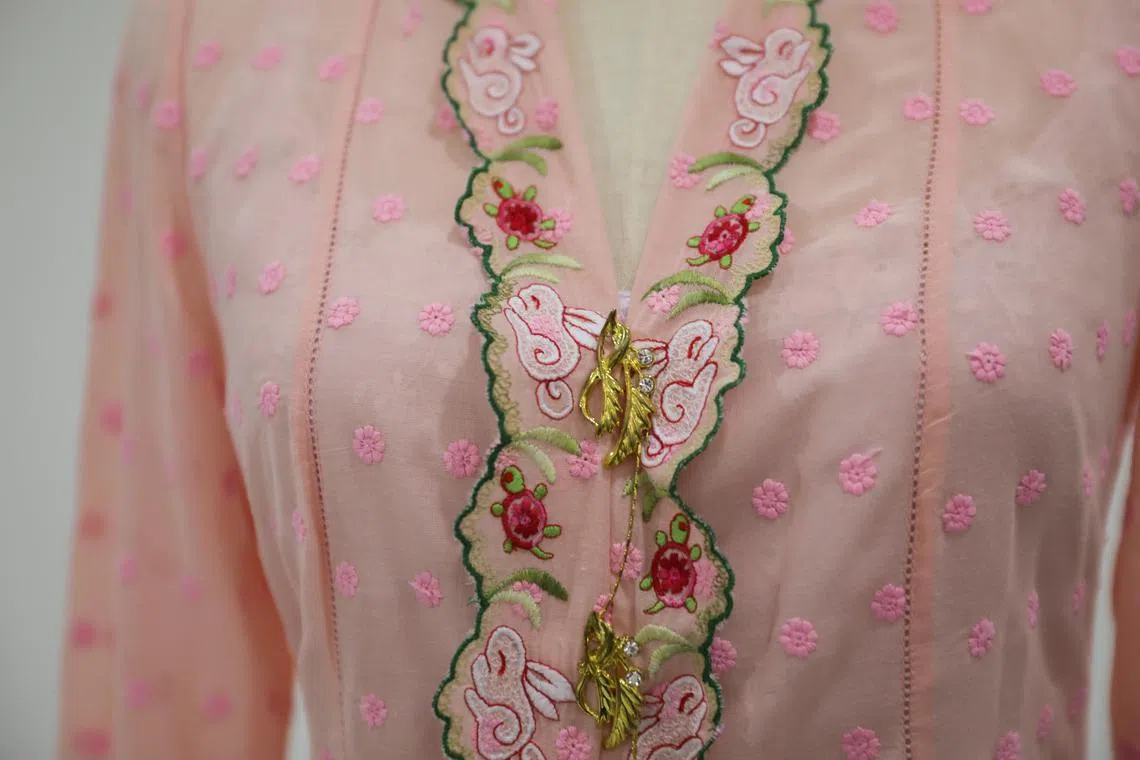
A kebaya worn by Chantalle Ng features motifs of rabbits and tortoises, a play on The Tortoise And The Hare from Aesop’s Fables.
ST PHOTO: TARYN NG
The second kebaya features embroidery of a rabbit jumping into a hole, which Mr Wong says is a depiction of the idiom “going down the rabbit hole”, taken from English author Lewis Carroll’s Alice In Wonderland.
“It’s a metaphor for Anna’s deceptive nature, how she is so absorbed in being the villain that she loses track of everything,” he adds.
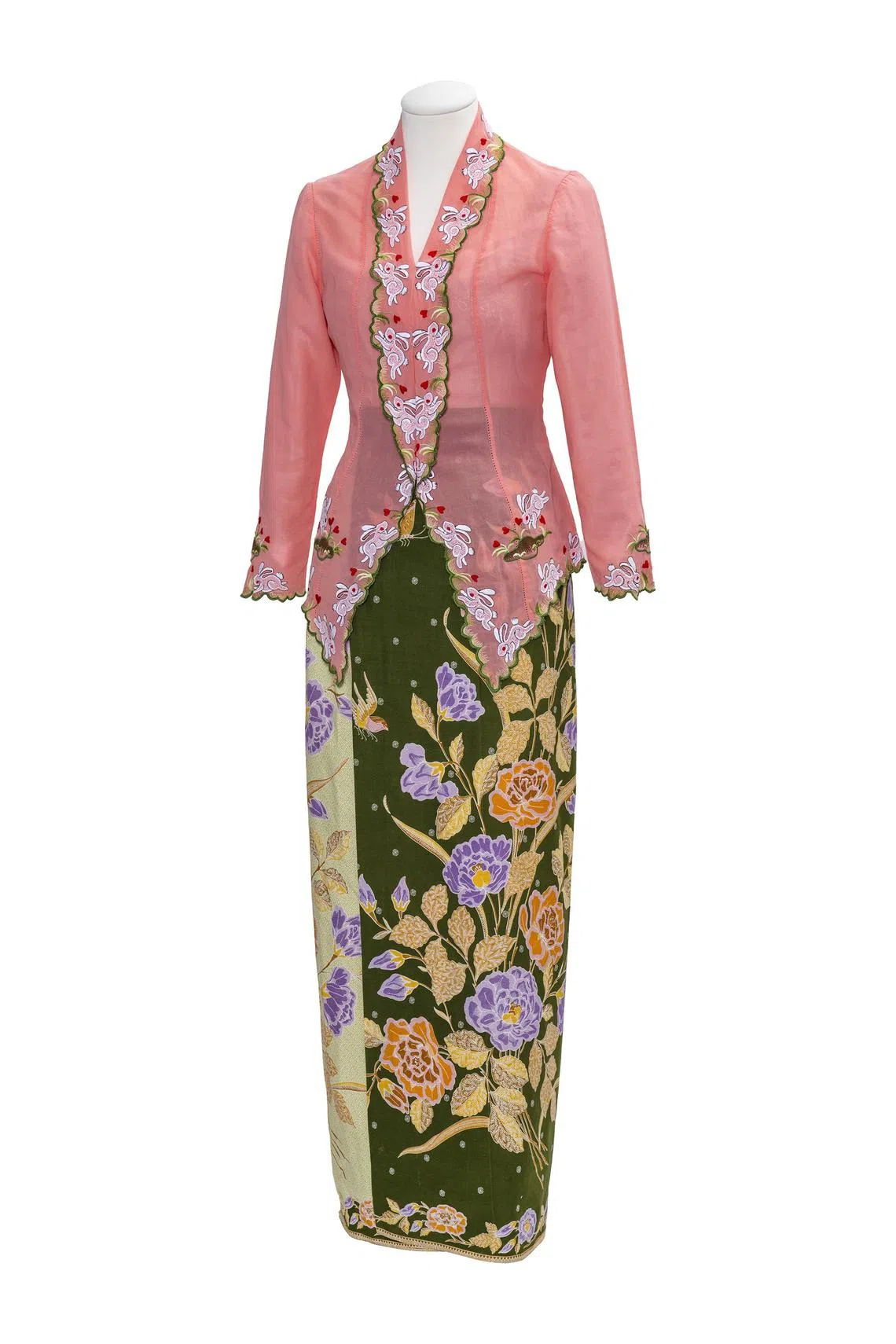
Another kebaya Chantalle Ng dons also features a rabbit design, this time inspired by Lewis Carroll’s novel Alice In Wonderland. The outfit is on display at the Peranakan Museum.
PHOTO: PERANAKAN MUSEUM
The “rabbit hole” kebaya has been donated to the Peranakan Museum.
Zhang Xinniang (Tasha Low)
As Xinniang is a picture of positivity and optimism, her colour palette consists of bright yellows and blues. Although Low had about 10 kebayas made for her, two designs stand out.
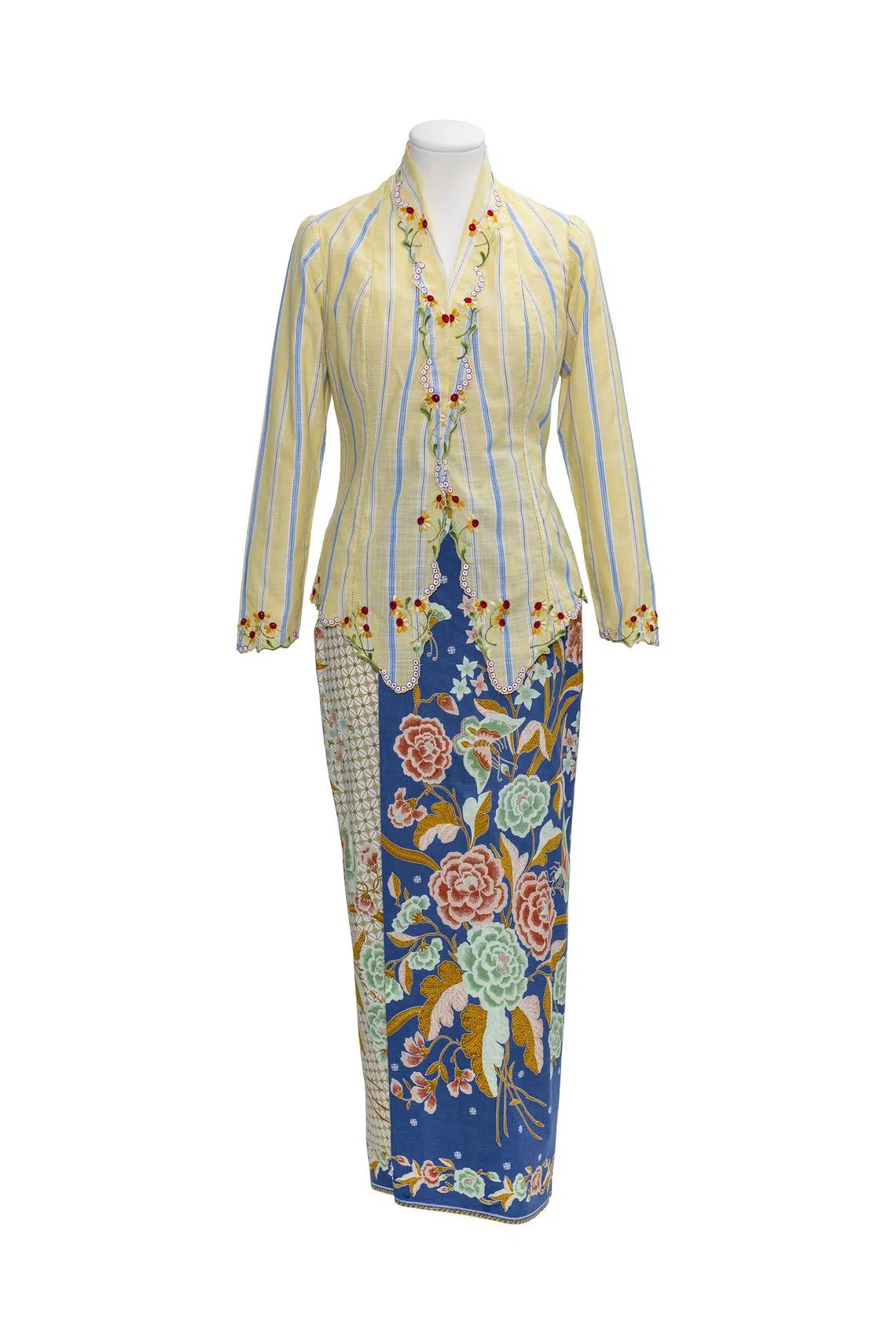
One of Tasha Low’s kebayas features daisies. It is one of the four Emerald Hill ensembles donated to the Peranakan Museum.
PHOTO: PERANAKAN MUSEUM
The first is a yellow kebaya with blue stripes decorated with daisies, which symbolise innocence, happiness and loyalty – key traits of Xinniang. The kebaya is paired with a bright blue batik sarong. This costume is on display at the Peranakan Museum.
Another statement kebaya features magnolias embroidered on white Swiss voile speckled with yellow woven dots.

Tasha Low wears the most kebayas in the series, and one of them is decorated with the magnolia, which symbolises beauty, purity and nobility.
ST PHOTO: TARYN NG
“The flower, which symbolises beauty, purity and nobility, is called yu lan in Chinese, which is found in the Chinese phrase that means the student surpasses the master,” Mr Wong says, explaining it represents Xinniang’s admiration for Yueniang.
Zhou Hongyu (Ferlyn Wong)
While Hongyu – an infamous prostitute who is later revealed to be a pivotal member of the Zhang clan – wears the cheongsam or Western dresses in most of the show, her kebaya is no less meaningful.
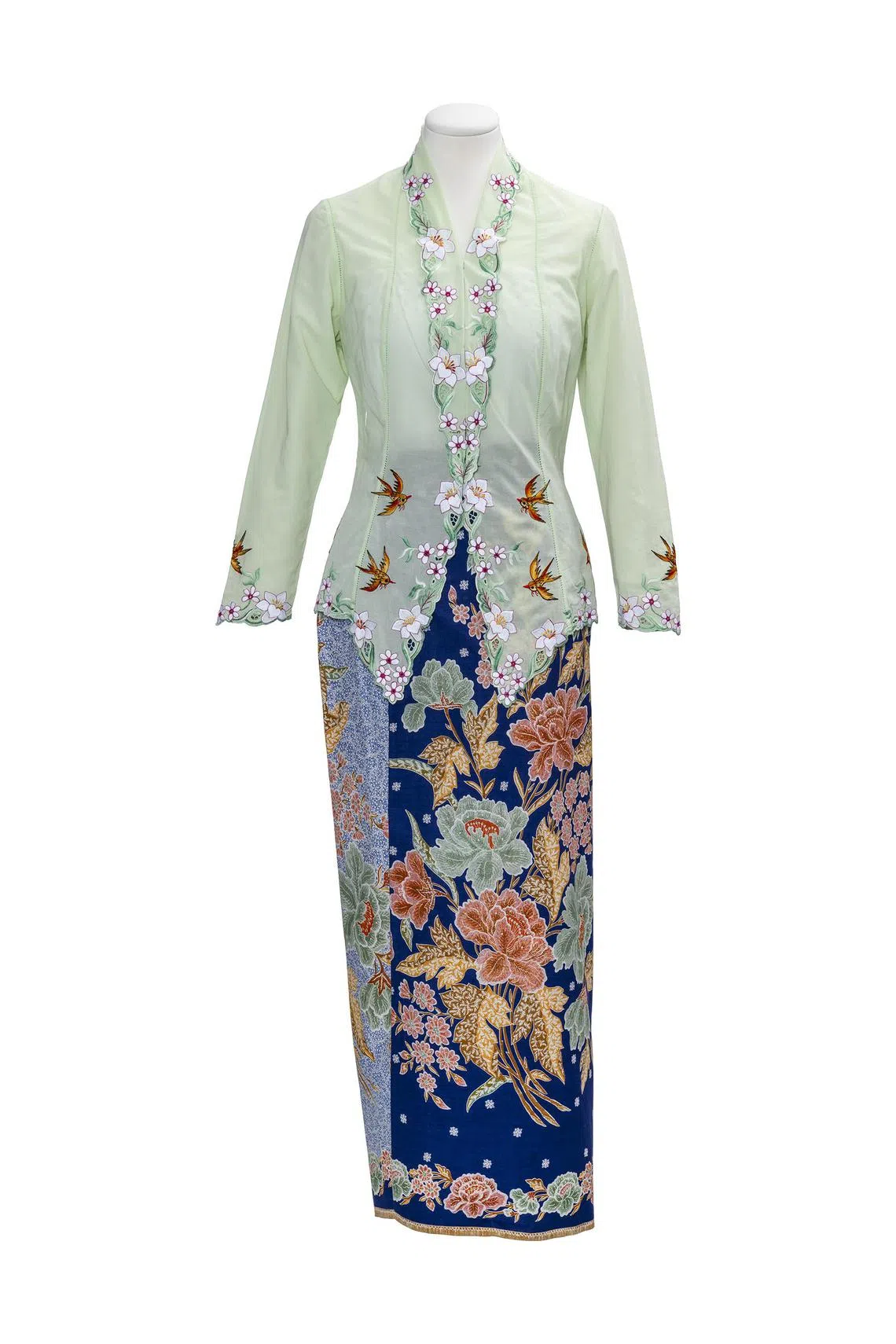
Swallows and peach blossoms feature in Ferlyn Wong’s kebaya, one of the four Emerald Hill ensembles donated to the Peranakan Museum.
PHOTO: PERANAKAN MUSEUM
Her mint-green kebaya depicts swallows and pear blossoms, both symbols of mourning, says Mr Wong.
He adds: “There is a deeper meaning to why I used these motifs, but I can’t reveal any more, lest I spoil the plot.”
This sarong kebaya has found a home at the Peranakan Museum.
Kang Sili (Dawn Yeoh)
Anna’s mother Sili is one of the smartest and fiercest members of the Zhang clan, and she does not shy away from being sexy.
Most of her kebayas are black and red, symbolising her Westernised background and rebellious personality, says Mr Wong.
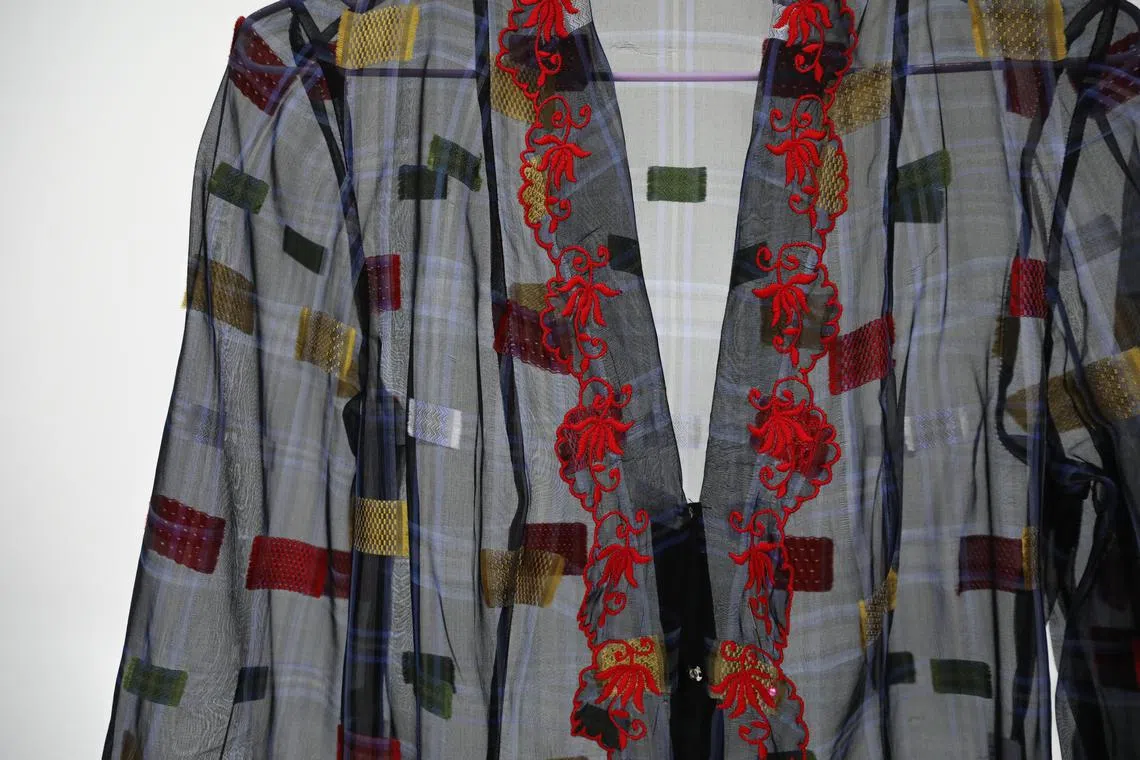
Dawn Yeoh’s kebaya featuring a black-and-red checkered see-through jacquard fabric symbolises her character’s sexy appeal. The red flowers are made up of chilli padi, representing her fiery temper and feisty nature.
ST PHOTO: TARYN NG
His favourite kebaya in the Emerald Hill collection is the black-and-red checkered garment made using a see-through jacquard fabric and emblazoned with only one colour – fiery red.
“Take a closer look and you will see the flowers are made up of chilli padi, symbolising her spitfire character,” says Mr Wong.
Zhang Yinniang (Sheila Sim)
The youngest of the Zhang children, Yinniang is an independent, modern woman trapped in a traditional household.

The tennis rackets and balls on Sheila Sim’s kebaya represent her character’s love for tennis and embody a modern woman trying to break free of traditional norms.
ST PHOTO: TARYN NG
As she rarely wears the kebaya, the only piece she owns has to be loud and one that commands attention. Mr Wong envisioned a bright blue kebaya where the key design elements are tennis rackets and balls, as Yinniang loves the sport.
“Delicate floral patterns will not suit Yinniang’s bold character,” he says.
Joanne Soh is a lifestyle correspondent at The Straits Times, with a special interest in entertainment and pop culture.


